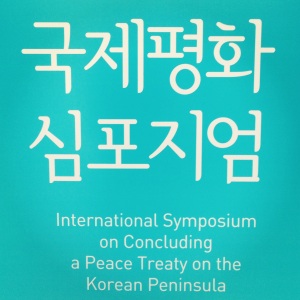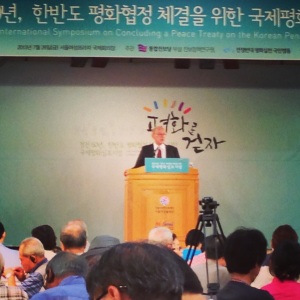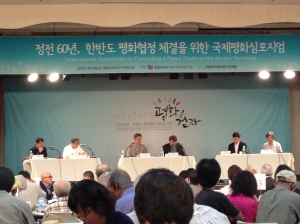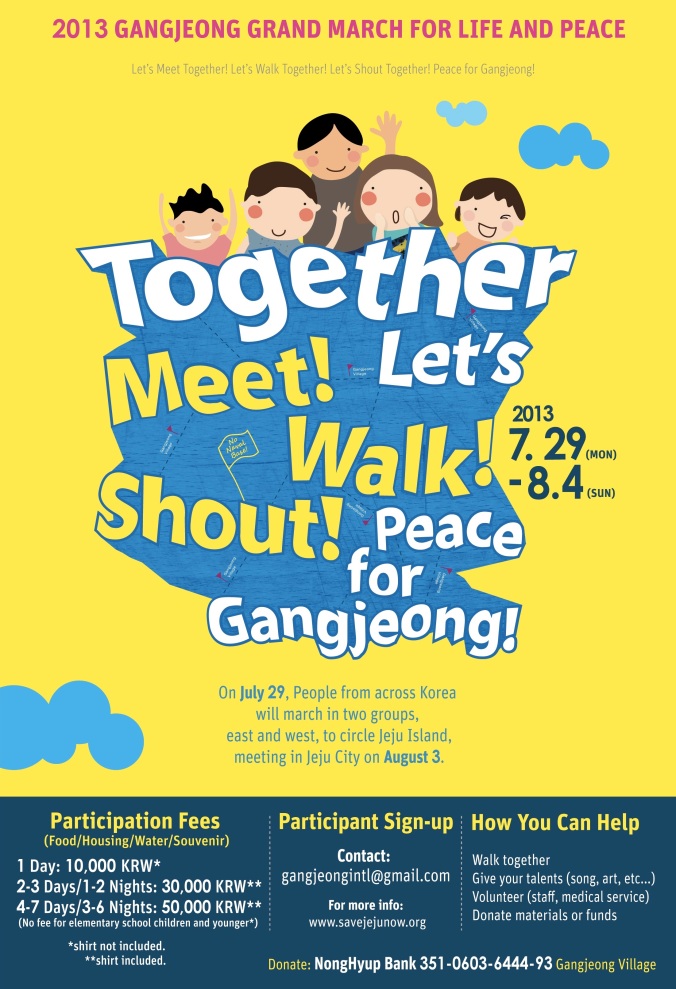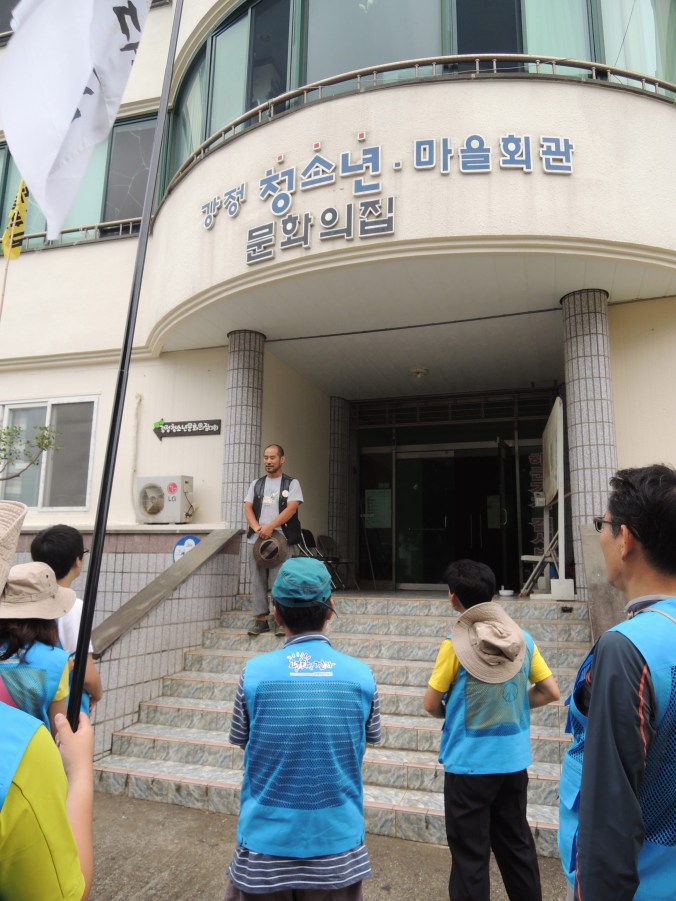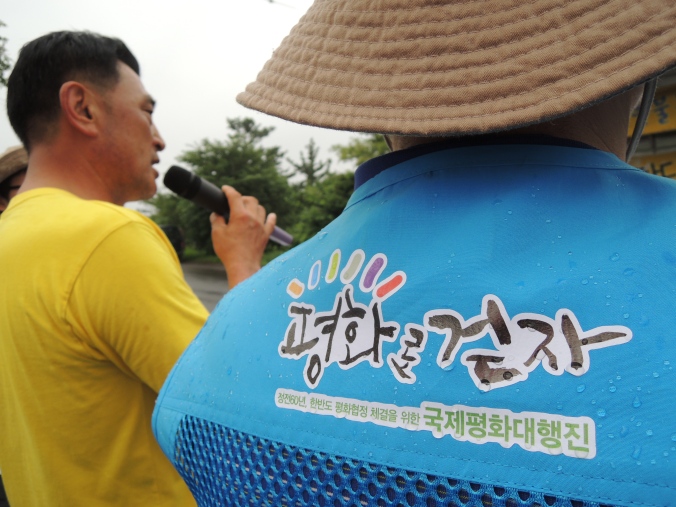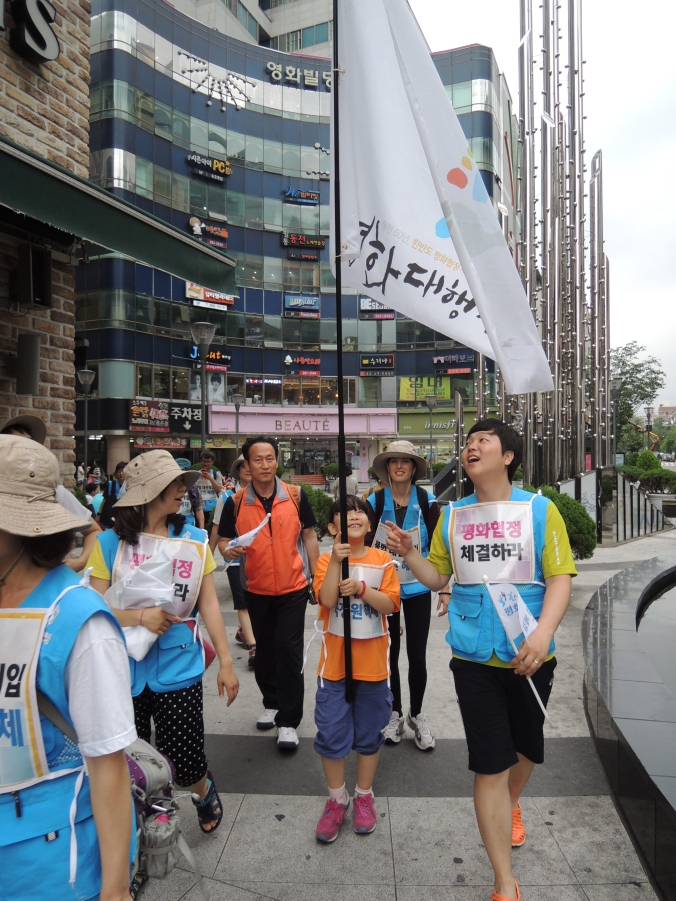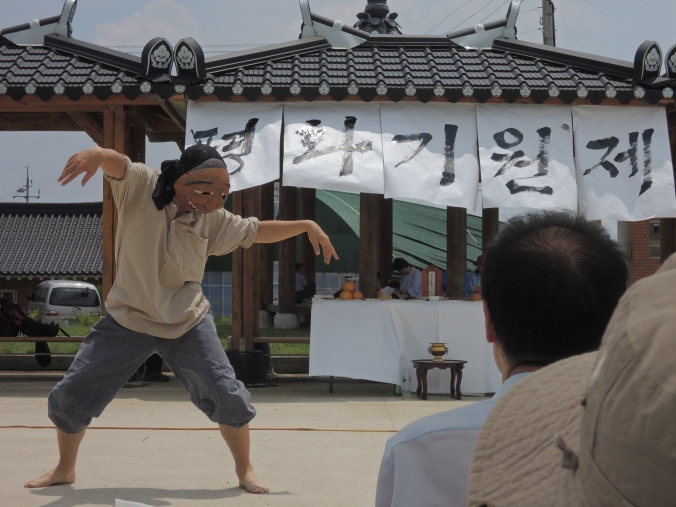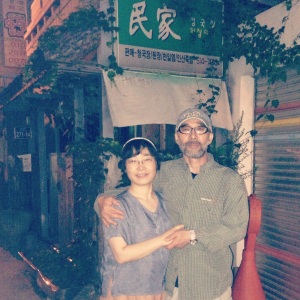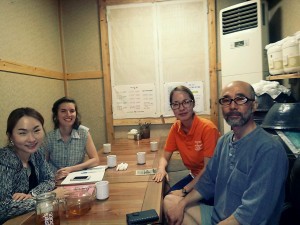We can easily forget as foreigners living in Korea that we are living in a forcibly divided country still at war. Join the ISC in a reunification tour to explore regions of significance to the inter-Korean conflict. You can sign up at http://bit.ly/1eTvmEL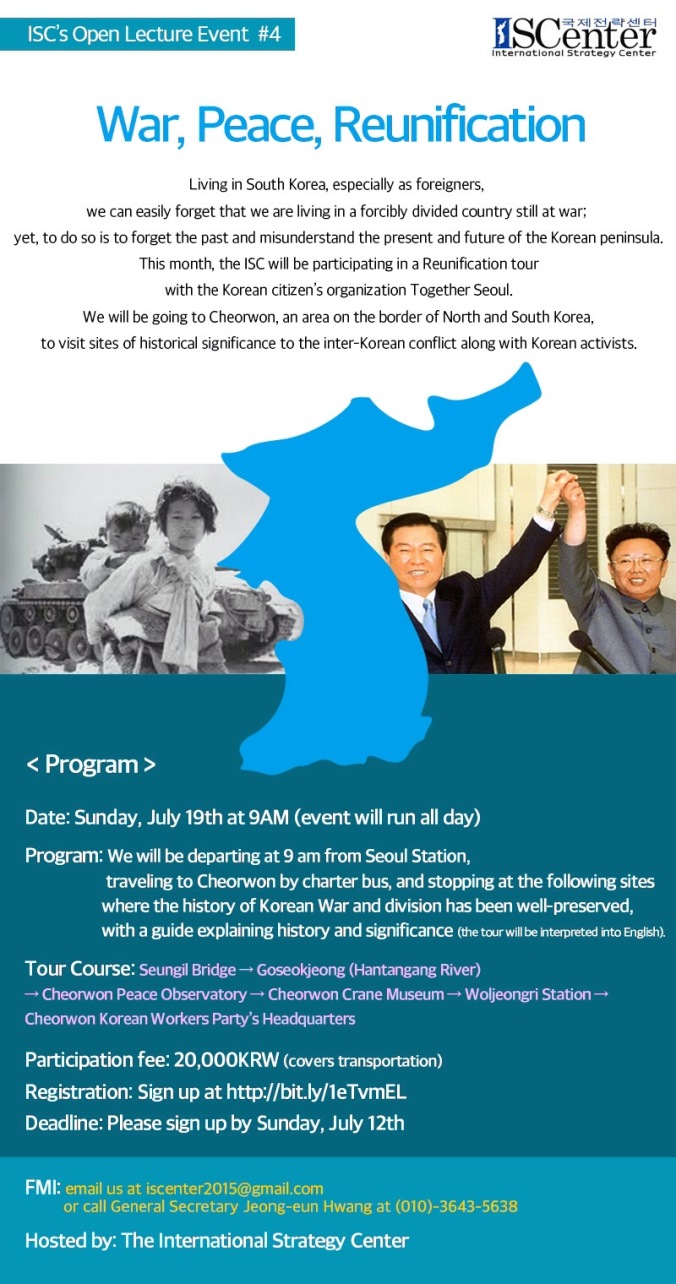
reunification
Learning to Live with Purpose
By Erica Sweett
A few months ago the ISC met in Seoul to learn about reunification. We met with reunification activist and former political prisoner, Kwon Nak Gi. At the age of 26, he was imprisoned for breaking the National Security Law in Korea. He spent 18 years of his life in jail, from 1972 to 1989. Trying to relate to a man whose world differed so much from my own was difficult. It raised important questions and forced me to reflect on how I have been living my life thus far.
I have always been interested in social issues. This led me to pursue a degree in political science at university. While I liked the idea of social justice, my understanding of politics at the time didn’t go much past the pages of the classroom textbooks. Yet the past two years I’ve spent in Korea have made me increasingly aware of the role politics plays in the life of everyday people. As I have become more familiar with the Korean social movement, activists and politicians, I have realized that awareness and change stem not from inconsistent ideals but from the lives of dedicated individuals. All of the people we have met have had at least one thing in common: they are all distinctly aware of their purpose. They have sacrificed comfortable, stable jobs and are devoting their lives to improving their community. The big question is, how? How did they discover and find the strength to live each day with purpose?
Kwon Nak Gi’s experiences in prison left him with nothing but his purpose. They took away his clothes, possessions, his home, family, country, and physical freedom. In the eyes of his oppressors, they had successfully dehumanized him. Solitary confinement was supposed to dissolve his beliefs, but it only strengthened them. After hearing his story, it was evident that the thing that makes us human is not superficial, but something that lies deep within us.
Kwon Nak Gi told us that he found strength in three basic ways; everyday resistance to his conditions, studying, and through comradery with his fellow prisoners. It was these basic intentions, along with his unwavering commitment and internal strength, that helped him endure life in prison. A simple confession could have given him the freedom to return to his family. Yet he firmly believed that a life without meaning would be much worse than a life behind bars. While most people reading this will hopefully never have to face what he did, his story is an important lesson on how to live an honest and meaningful life in spite of your conditions.
He started by telling us about how he was always actively struggling, whether he was physically resisting torture or internally resisting confession. Each time he was tortured, his reasons for resisting were reinforced. Each time he refused to denounce his beliefs, he further solidified his commitment to them. Struggle doesn’t always come in the form of organized protests. People make the struggle a part of their everyday lives. While in prison, Kwon and the other prisoners never forgot their reason for fighting.
Education and learning proved to be another important tool for resistance. Prisoners had limited resources and were not allowed to have books. Books were seen as a pleasurable distraction and were thus banned. Within the limits of their prison cells the prisoners, made up of political thinkers, students and professors, worked together to share their knowledge. Kwon told us this as he tapped his finger on the table. He explained that the prisoners transcribed books to one another using morose code. “If you didn’t do the studying and keep the spirit inside, you couldn’t last the whole prison term,” he reflected. Opening the mind and broadening one’s perspective is crucial. Learning and teaching in any form gives substance to life and in this case, made life in prison more tolerable. It gave space for the growth and change needed to continue participating in their struggle while imprisoned.
The third way that Kwon Nak Gi found strength was through comradeship with his fellow prisoners. Because of the bond between prisoners, he was never fighting alone. He told us that “animals can’t resist oppression, but human beings can fight oppression together, so in prison we struggled together.” The prisoners would find ways to help one another, however small, such as making sure to take care of the elderly and sick prisoners. The weight and power of oppression is too much for a single person to carry on their own, but with the help of a strong community, solidarity quickly forms.
Kwon Nak Gi has taught me that to fight for your beliefs is not enough. You have to become them, living each moment with intention. In unsettling times, when everything could be taken from you in an instant, the only thing that you have is not outside of yourself – it is within. Kwon Nak Gi was tortured for 25 years yet, he sat in front of us smiling as he recounted the years of his life spent he spent in prison. He was always free because from behind the bars of his cell he was committed to living each day with a purpose, moving forward and resisting. His time was never wasted because he utilized what he had – the struggle, his mind, and his compassion for his fellow prisoners – to separate himself from the oppression and fight against it.
On the surface, his story may evoke feelings of pity. He sacrificed years of his life struggling for the reunification of a country that remains divided. But after listening to him speak, I instead felt hopeful. If a single man can endure so much loss and sacrifice for 18 years of his life while still firmly holding on to his beliefs, then just imagine the implications that has for a nation.
Kwon Nak Gi’s words and experiences contain an important message. On a personal level, he helped me understand that it is not about finding your purpose. Rather, it is about striving to constantly remain aware of and live by your purpose, especially in the moments when it feels like there is nothing left for which to fight. As he poignantly stated near the end of our meeting, “people need to never forget their reason to exist.”
Struggle and Camaraderie : Survival as a Korean Long-term Political Prisoner
By A.T.
I am a 27-year-old American expat English teacher in Korea. My major challenges are: navigating a foreign culture and language, making good lessons, and balancing my life. At 25, Kwon Nak-gi and his family went to prison for violating the National Security Law with their pro-reunification activities. During his time in prison, 1972-1990, Kwon’s major challenges were enduring the beatings, torture, and solitary confinement that placed pressure on him to betray his political beliefs and comrades. Listening to Kwon’s account of his prison experience on a Sunday afternoon in June, I asked myself: “What do I stand for? Why do I exist?”
Korea’s prolonged division makes criminals of those who could help build it into a better society. Amidst widespread condemnation of North Korea and other regimes, a little-known fact about South Korea is overlooked: it boasts the world’s longest-serving political prisoners, some of whom have served over forty years. As Michael Breen explains in his 2011 Korea Times article “The Case of World’s Longest Serving Political Prisoners,” Park Chung Hee’s iron grip in the 1960s drove these men from the public consciousness. Many of these unconverted dissidents – who never renounced their beliefs – have died or been killed in prison, but others like Nak-ki survive to tell their stories to the younger generations.
One night, returning to his solitary cell, beaten and bloodied, thoughts of caving in and signing the release papers emerged in Nak-ki’s mind. He had a girlfriend and a good life: signing seemed like such an easy way out. It was seeing the faces of his older comrades that made him realize he could never betray them and his conscience. So he endured until 1990, when Korea’s burgeoning democratization saw the release of the first round of long-term prisoners under Roe Tae-woo.
The Saturday before meeting Kwon Nak-gi, Justice Party candidate and reunification activist Jeong Yeon-ook compared the divided Korean peninsula to a living cell or a person. Jeong said: “If you put together countries that were never meant to be together, they will split apart, but countries meant to be together will come together.” While the former Soviet republics are now proudly independent countries, Korea entered the UN in 1991 as a sadly divided nation. To this day, the governments of the US, DPRK and ROK have been unable to propel this living cell back together. How much longer will this division last?
In the 1940s climate of the Japanese occupation followed by US occupation, leftist anti-colonial movements flourished but were quickly crushed. The window of opportunity for a truly autonomous Korean nation seemed to close under the weight of continued oppression and a brutal 3-year war. Divisions between pro-Japanese collaborators and those staunchly against the occupation plagued society before the demarcation line was even drawn and they only deepened over time, leading to a military border that separates families and national history.
To someone like me who comes from outside this society, Kwon Nak-gi’s account offers immense insight not only into Korean history but human resilience. Yet I’m afraid that many of those in the younger generation here are too concerned with their status and career-building to take advantage of learning lessons from the past and acting in the present. While the June reunification weekend left me with more questions and doubts than answers, one thing is clear – I respect people who have given their lives for the cause of peace and reunification. I hope to learn from their struggles and emulate their level of commitment to a cause. Above all, I hope to one day see Korea reunite as one strong, independent country.
Based on interviews with Jeong Yeon-ook and Kwon Nak-gi, Seoul, June 14-15, 2014
Breen, Michael. (2011, February 20). The Case of World’s Longest Serving Political Prisoners. koreatimes.com
Unbroken: Kwon Nak-gi, Long Term Political Prisoner of Conscience
By Dae-Han Song
On June 14th, Kris Pak, an adoptee; Stephanie Park and Dae-Han Song, two Korean-Americans; Taryn Assaf, a Lebanese-Canadian; Anastasia Traynin, a Russian-American; and Erica Sweett, a Canadian meet with Kwon Nak-gi: trim, neatly dressed, nearing 70, set of black hair, hint of slouch, and tattooed eyebrows. He speaks with the earned conviction and justification of one who stayed true to his beliefs and comrades in the face of torture and 17 years of solitary confinement.
The National Security Law
Kwon, Nak-gi was arrested in 1972 (along with his father, mother, and younger brother) for violating the National Security Law in the incident of the Gyongsang Province Revolutionary Party for Reunification. The National Security Law had been created soon after liberation from Japan to repress the uprisings erupting from a divided South Korea: On one side stood the nationalists, communists, and socialists; on the other, the Japanese collaborators. Since that time the National Security Law has been used to censor, incarcerate, torture and kill dissenters. Those imprisoned are grouped between ones who renounced their beliefs under torture, and ones who did not. Separating those let free and those that persisted was a signed statement renouncing one’s beliefs. Those that persisted are referred to as prisoners of conscience. Kwon Nak-gi is a third generation long term political prisoner of conscience.
Four Generations of Political Prisoners
The first generation of political prisoners was arrested at the end of the Korean War: they had fought for the North but were trapped in the South when the war ended. Some were executed; others received life sentences eventually serving up to 40 years. The second generation was arrested upon returning to the South in the early 1960s to jumpstart the South’s reunification movement. The third generation was too young to fight in the war but old enough to participate in the South’s reunification movement in the early 70s. The fourth generation was arrested in the latter half of the 1970s, framed as spies to justify the continued existence of the National Security Law. They were later retried and found innocent, including those executed and those killed in prison.
Struggle and Freedom
As the struggle for democratization intensified, pressure to release the political prisoners mounted. Many, including Kwon Nakki, were released after the October 1987 uprising. Others were released under Kim Yong Sam, and finally one by one the remaining unconverted long term political prisoners were released under the Kim Dae Jung presidency. 63 of them were repatriated to North Korea as a humanitarian gesture under the June 15, 2000 agreement between Kim Dae Jung and Kim Jong Il.
Prison Life
As we move from the background to his story, I ask, “What was prison life like?” Kwon Nak-gi describes the cells for political prisoners: Each prisoner was held in a 0.75 pyeong (2.5 square meters) cell: just large enough to sit against one wall and touch the other with your feet. To break them, the prison kept them under solitary confinement. “In our cells, we didn’t have any books. If you had books, you could escape. They wanted to keep the pressure on: They wanted us to feel sadness, misery, loneliness.”
As he relates his daily prison life, I glimmer moments of resistance, persistence, and dignity in the mundane: keeping mind and body busy, strict adherence to hygiene and exercise, and even discipline and resourcefulness in the use and reuse of a pail ration of water.
Strength
“One of our greatest sources of strength was study. Among the hundreds imprisoned, we had philosophers, professors: learned people. So, they created lessons on dialectical materialism, contradiction, the principles of an organizer, political science, economics.” While each of the political prisoners was kept in solitary confinement, they communicated through a secret system of taps, scratches, and knocks on the wall.
“We would sit alone in our room doing these studies. Our elders would tap out a sentence on the wall. Then I would recite and memorize it in rhyme.” As he demonstrates by tapping, scratching, and knocking in rapid succession, he murmurs off a string of sentences from memory. “It’s been so long, that I’m starting to forget them…It took me about a year to memorize it all.”
“After breakfast and the dishes, I would recite my lessons. It took exactly three hours. Without that, there was no way we could have held out for 10, 20, 30 years. A human being needs a purpose and a practice. That’s the only way to endure. We have to remind ourselves why we exist. For us, it was important to not while away the day. That’s why we studied everyday. It gave us a purpose.”
“The second source of strength was struggle. If they simply left us alone, we would have become bored, listless. But, they tortured us. All animals fight back when you mess with them. But, humans are special: We also fight back when someone messes with others. That is our strength. If they beat one of us, then the others would start a hunger strike. These struggles helped keep our humanity.”
“Study, struggle, and finally comradeship. I wonder if without comrades I could have kept my beliefs for so long.” Kwon Nak-gi relates how, in winter, younger prisoners would pad their underwear and in the exercise yard would exchange it with the worn-out ones of the older prisoners. Or of when someone had diarrhea, he would save his food and pass it on to hungry comrades despite punishment if caught.
His voice recalls a past moment, “One day after getting tortured, I returned to my cell. I was bloodied; my energy was drained. As the sun set and night fell upon me, my eyes welled up with tears. I wondered to myself, ‘Do I really need to keep getting beat up like this?’ My thoughts wandered off to a woman back in Busan. ‘Why did I listen to my father? Why don’t I just give up and live comfortably outside?’”
“The next morning, through the food slot, I saw a senior comrade in his 50s – his skin down to his bones – raising his fist motioning me to stay strong. At seeing that, there was no way I could sign the renunciation document. How could I leave behind all these elders and comrades to live comfortably outside? I stuck it out to the end not because I was smarter, or tougher, or better. It was these relationships. It was these moments, once, twice, thrice, ten times, one year, ten years, twenty, as time flowed…that is how I was made. No one is born good or bad. Our education, our actions – that is what make us.”
Releasing the Han
Anastasia asks, “What are your goals now?” The question stirs a reflection. Kwon Nak-gi pauses then responds, “When you say goal, there is that which forms in our rational self, from our knowledge, which we plan and then try to execute, and there is that which forms within our hearts and releases our unresolved feelings, our Han. The goal which resides in my rational self and in my heart, are one and the same: reunification.”
His “rational” reasons for reunification are many: an independent country; military spending used for social welfare instead; and the freedom to hear, read, learn what one wants and to choose freely. Then, a profundity permeates his voice, “Reunification is also an ardent wish that resides in my heart. We all make promises, like today, we made a promise to meet here. But, a promise between living people, can be changed, postponed, or even canceled if both acquiesce. A promise with those who’ve died cannot be canceled, postponed, or altered. That is the han that resides in the hearts of those that survived. I made a promise to my elders that I would struggle on until the reunification of our homeland. They died in prison. Even my juniors, who I loved and cared for, that were released but passed away, we promised to fight for reunification.”
Advice for the next generation
As our meeting comes to a close, Anastasia asks, “Do you have any advice for the next generation?” Kwon Nak-gi’s voice mingles with delight, expectation, and respect as he answers, “Dialectical materialism states that the new will replace the old, and that the new becomes old. Nothing remains fixed. I see myself as the old: I am 69. You are young; you are in your twenties, in your thirties. I can’t tell you how to live your lives. But, I can tell you that while I spent my twenties and thirties in prison, I never lived in shame. I didn’t accomplish anything great, but I never betrayed my beliefs. I did not live in fear; I did not live in shame. Because you are young, your dreams, your directions, they will all be varied. But, live your life free of fear and shame. To do that, you must preserve your confidence and maintain your self-respect.”
Reframing Reunification
By Stephanie Park
I don’t remember exactly when I learned about Korea’s division into North and South; but I do remember the immediate conviction I felt that the two should be reunified. I didn’t know much about the South, and even less about the North, but my childhood self was convinced it needed to happen. Perhaps, I perceived a desire, unspoken but felt, of my grandparents to return to the provinces where they were born. Perhaps I was simply parroting the idea that Koreans were one people, and should therefore be one nation as well[1]. Or perhaps I just liked the idea of a happy ending. Regardless, before I became serious about critically examining Korean politics, reunification was the one topic I had any opinion on.
It was thus disorienting when after the ISC’s June program on reunification, I found myself more confused about the issue of reunification than I had ever felt before. Addressing reunification is impossible without addressing the matter of “the world’s most isolated country[2].” While I’m no expert on North Korea, like countless others I had always assumed that there were certain things I could simply take for granted: for example, that the North was responsible for the Korean War, that it brainwashed its citizens into worshipping Kim Il Sung and Kim Jong Il, and that the country was hell-bent on building up its nuclear weapons program to threaten the US and South Korea. Volunteering with North Korean defectors gave me an additional perspective, one that focused on the scarcity of food and resources and painted the situation in North Korea as a human rights issue. I was therefore taken aback by the attitudes of the South Korean activists that we met and their attitude towards the North, which was more nuanced and challenged me to critically examine everything I’d ever thought about the country. As I investigated the issue further, I began to realize how little I knew of the forces that shaped the North Korea that we (think we) know, how deeply and completely my and others’ understanding of North Korea has been shaped by American neoliberalist motives, and above all, that a paradigm shift is necessary to achieving a reunification that truly achieves peace and justice on the peninsula.
As I delved into Korean history to seek answers, I found that to discuss reunification necessitates discussion not only of North Korea, or even the Korean War, but of Japanese colonialism. In a way, the conflict between North and South reflects the still-unresolved conflict between Koreans themselves during the occupation between those who resisted and those who collaborated. The current power hierarchies of both countries reflect that, with the Kim family and other guerilla fighters at the helm in the North, and collaborators who stayed in power through US intervention in charge the South. The unresolved trauma of Japanese colonialism was so central to Korean politics at the time that, in the opinion of historian Bruce Cumings, “a civil conflict purely among Koreans [emphasis added] might have resolved the extraordinary tensions generated by colonialism, national division and foreign intervention. [3]” Yet, such a resolution was never to be, as Korea was divided arbitrarily by the American military and summarily offered to the USSR as a preemptive compromise in the Cold War conflict. Korea’s division was something I had simply accepted as a child, but revisiting it now, I am struck by the arrogance of dividing another people’s country without any thought to those that inhabit. Yet, this act shows that, from the very beginning, America’s treatment of Korea’s was never that of equals, but as a pawn to be sacrificed to further US interests. Similarly, I had always thought of the Korean War as the fault of a blood-thirsty North; yet if we contextualize the war as a civil conflict in the wake of division by more powerful countries compounded by the lack of resolution of the injustices from Japanese colonialism, it becomes clear that civil wars do not start, they come. [4] If we examine history, it is clear that both Kim Il Sung and Synghman Rhee desired war to reunify the country. Yet, despite its civil origins, once the war began there were just as many atrocities committed by the US against Koreans than between Koreans themselves, including the massive use of chemical weapons, systematic burning of villages, and destruction of dams affecting 75% of North Korea’s food supply[5]. Perhaps most tragically, the bloodshed proved to be for nothing, as the war ended in an armistice, leaving both Koreas in a state of war to this day. As a kid, I’d grown up with the narrative of MacArthur sailing into Incheon to “save” the Korean peninsula, but given his support (and even advocation) of bombing the North in the name of procuring military victory, it’s clear that the US’ presence brought more death and destruction than it ever brought peace.
Of course, when we think about North Korea today, it is usually with regards to its nuclearization. The imagery of North Korea as a crazed weapons-stockpiling nation that could go berserk at any moment is one that dominates both mainstream media and my family; yet, a critical examination reveals that North Korea’s developments have largely aligned with the desire to either a) exercise self-sovereignty, or b) react defensively to US actions. For example, much was made in 1993 of North Korea’s withdrawal from the Nuclear Non-Proliferation Treaty – but how many people knew that it was due to the International Atomic Energy Agency (IAEA)’s demands to carry out “‘special inspections’” in North Korea, ones which could be utilized to gather intelligence for the United States (a violation of the IAEA’s own mandates)? Similarly, while I had always agreed with the US’ mandate that North Korea de-nuclearize, upon further investigation, I realized how the US has utilized a denuclearized North Korea as a tool to push for unrestricted access to North Korean information, essentially holding peace in the peninsula hostage[6]. Aside from being hypocritical,[7] it’s also a clear violation of any country’s basic right to sovereignty and attempt to subordinate North Korea.
Of course, the fact that such information rarely comes to light is indicative of just how successful American media has been at naturalizing its own stance, and delegitimizing the North Korean perspective, to the point that even those interested in international solidarity continue to see North Korea as simply “that crazy country.” Yet, for all the focus on North Korean propaganda, we fail to see how deeply ensnared we are in our own. We call North Korea “ ‘crazy’ ” – but is it any crazier than a nation that claims to value justice and equality for all, while actively punishing a country whose actions are in the name of self-determination? Is it any crazier than a country that decries the human rights violations in North Korea, yet implements sanctions and refuses to provide aide and is thus directly responsible for these problems in the first place?
I am still struggling to develop my own understanding of reunification and North Korea while holding the contradictions that have developed and that sometimes seem to pull me in opposing directions. How do I honor my grandparents’ history (and thus, my own) while also challenging it? How can I have admiration for the North Korean defectors I have met for their courage, and respect the hardships they have endured, while also not falling into the trap of praising them simply because they defected and contributing to their use as political tools of the US and South Korea? And how can I have an understanding of North Korea and reunification that is critical yet hopeful? I confess that I don’t have an answer to these questions yet. However, one thing I do know is that, as an American, I recognize the burden we bear as citizens of a country who has wronged the Korean people, North and South, and promise to do what I can to contribute towards restoring peace and unity on the peninsula in a way that has the Korean people at heart.
[1] See: Minjok ideology. According to Luc Walhain in “Transcending Minjok: How Redefining Nation Paved the Way to Korean Democratization,” “while the original meaning of “jok” in minjok was “tribe” sharing a common ancestor, “jok” is now more generally used to designate a race, or ethnic group, e.g. “mong-jok,” meaning Mongolian race. When “jok” is combined with “min.” (people), as in “minjok,” the word becomes loaded with a heavily racial character. It refers to the Korean “nation,” but puts a strong emphasis on the Korean people’s sharing of common blood and a common ancestor, Tan’gun. It is an emotionally loaded term which has been used with great effect to call for the Korean people’s absolute and unconditional love and loyalty for the nation.” (http://studiesonasia.illinoisstate.edu/seriesIII/Vol%204%20No%202/s3v4n2_Walheim.pdf)
[2] http://www.worldpolicy.org/sites/default/files/uploaded/image/Spring13_22-23_Anatomy(1)_1.pdf
[3] Bruce Cumings, “The Korean War.” (http://books.google.co.kr/books?id=lY5-7ZirsmgC&pg=PA35&lpg=PA35&dq=a+civil+conflict+purely+among+Koreans++might+have+resolved+the+extraordinary+tensions+generated+by+colonialism,+national+division+and+foreign+intervention&source=bl&ots=7GcXcT3n2n&sig=HGA7wUHvb_ogbldGv3taXJGFvLs&hl=en&sa=X&ei=v_ASVIn_AcK58gWy3ICQDw&redir_esc=y#v=onepage&q=a%20civil%20conflict%20purely%20among%20Koreans%20%20might%20have%20resolved%20the%20extraordinary%20tensions%20generated%20by%20colonialism%2C%20national%20division%20and%20foreign%20intervention&f=false)
[4] Bruce Cumings, Korea’s Place in the Sun.
[5] Bruce Cumings, Korea’s Place in the Sun.
[6] See: Korea Policy Institute’s “The Case for a Peace Treaty to End the Korean War” (https://solidaritystorieskr.files.wordpress.com/2013/04/caseforapeacetreaty.pdf).
[7] The last time the US divulged that kind of information was due to Edward Snowden, and there’s a reason he’s still in Russia.
The Current Status of Peace on the Peninsula: An Interview with Jejun Joo
Interviewed by Dae-Han Song
Jejun Joo is the Policy Chair of the Korea Alliance of Progressive Movements (KAPM) and the People’s Action Against the War and the Realization of Peace. The KAPM is a broad alliance of sectoral (workers, peasants, women, students, and a political party) and regional social movements in South Korea and a leading alliance for peace and reunification in the Korean Peninsula. The People’s Action Against the War and the Realization of Peace is a coalition of social and civil society movements recently created to deal with the current war crisis in the Korean Peninsula.
The interview is meant to shed some light on the current conditions on the Korean Peninsula regarding peace as well as offer analysis and perspective from some of Korea’s leading peace and reunification social movements.
Dae-Han Song: Can you provide some background to the current state of affairs?
Jejun Joo: Sure, there have basically been five agreements since 1994 between the United States and North Korea, all of which the US has consistently reneged on. I think this is the way that North Korea understands the situation: We are no longer interested in dialogue for dialogue’s sake or dialogue as a stalling tactic [on the part of the United States]. It is within this context that North Korea has realized its nuclear capability. We can see this as the backdrop to our current situation. Without any genuine dialogue between North Korea and the US, there is a high chance that tensions will continue and might even escalate.
Dae-Han Song: Do you think that ultimately the US will recognize that reality?
Jejun Joo: I think it ultimately has no choice but to do so. One important point I want to emphasize is the April 11th announcement at the House of Reps. hearing by Rep. Doug Lamborn of the leaked Defense Intelligence Agency report.[i] In it, the Defense Intelligence Agency acknowledged the possibility that North Korea possessed the ability to arm its ballistic missiles with nuclear warheads.
Dae-Han Song: Can you talk about the chain of events that led to the current situation?
Jejun Joo: If we start from 1994,[ii] it will be too long and complicated, so let’s just start a little bit closer to today. Let’s start in 2009. In April 2009, North Korea launched a rocket to put a satellite into space. Then in May, it conduced its 2nd underground nuclear test. In response, former president Bill Clinton visited North Korea that August and came back with two American journalists that were being held in Pyongyang. This was followed by another vists by Special Envoy Stephen Bosworth in December. After the visit, Stephen Bosworth announced in a press conference in Seoul that North Korea would return to the 6 party talks. The six party negotiations concluded with the February 23 agreement. The mood for dialogue greatly improved.
In 2010, between February and March there were secret negotiations held between North Korea and the US in Berlin and in China. A peace regime was even brought up as a possible scenario. However, this was all shattered in March with the sinking of the Cheonan corvette in March 26th. The sinking of the Cheonan corvette is a great example of the US role in South Korea, and if we examine it closely we can discern its motivations in the Korean Peninsula.
Dae-Han Song: What do you mean?
Jejun Joo: South Korean authorities stated that the Cheonan corvette was sunk by North Korea. Only one other country in the world agreed with this conclusion: the United States. As a result of these conclusions, South Korea levied its May 24th sanctions against North Korea and the UN issued a presidential statement. However, if you take a close look at the UN statement, it does not state that the cause of the Cheonan corvette’s sinking was North Korea.[iii] It never mentions North Korea as the cause. In other words, the only two countries that accused North Korea of sinking the Cheonan corvette are South Korea and the US. Even Russia and China criticized this conclusion.[iv] Even now in South Korean society there are many doubts as to whether or not the Cheonan was sunk by North Korea. There are many inconsistencies and unanswered questions.[v] That is why Russia and China were unwilling to sign onto the final report. Only the US agreed to back the report. Why? Well, I believe that US interests in the Korean Peninsula can be found here.
The US strategy was as follows: with the Lee Administration’s May 24th measures halting inter-Korean economic cooperation in response to the sinking of the Cheonan corvette, the Lee Administration began to apply great pressure on North Korea. Furthermore, the USS George Washington aircraft carrier entered South Korea. As soon as the USS Washington entered South Korea, China strongly protested the move. This is because the USS Washington has a military operational radius of 1000 kilometers[vi] including a long-range surveillance radar. From the point of view of China, all of its strategic information about its North Sea fleet would have been exposed. As tensions rose, South Korea now also had to purchase stealth fighters and Apache helicopters from the large US military company Lockheed Martin. Through increased tensions on the Korean Peninsula, the US was able to sell weapons to South Korea[vii] and also finally announce its pivot to Asia strategy, ultimately meant to pressure China. Thus, we can see the reason why the US supported the South Korean government’s report accusing North Korea as attacking the Cheonan corvette.
The most important consequence of this final report was that it completely stopped the dialogue that had been happening since 2009. In this way, the US gained various benefits from increasing tensions in the Korean Peninsula. When tensions escalate, opposition towards and pressure against North Korea increases and then when the US takes actions to de-escalate, it appears as if it is taking positive steps towards easing tensions while further isolating North Korea.
Dae-Han Song: Can you briefly tell me about the Obama Administration’s policies towards North Korea?
Jejun Joo: Obama’s first term was about achieving denuclearization through face to face dialogue. In the beginning he had stated that the Bush Administration’s policy of pressuring North Korea had only driven it further into developing its nuclear weapons, and that his policy would be one of dialogue. However, as he became more embroiled with the Middle East crisis, he was unable to establish a real North Korea Policy. Ultimately, he adopted strategic patience. This strategic patience contained two components: isolating North Korea and refraining from dialogue. It is in reality a strategy of waiting for North Korea to collapse. In 2008, North Korean Chair of the National Defense Committee Kim Jong Il had a stroke, and the Obama Administration decided to wait until the Kim Government would collapse. This was the origin of strategic patience. However, strategic patience failed in 2009. There was the nuclear test and as I stated before, direct talks between North Korea and the US followed in 2010, 2011, and 2012 ending with the February 9 agreement. Through this process the Obama Administration gave up one of the elements of strategic patience by moving towards US-NK dialogue. This can be seen as Obama’s 2nd term strategy.
For his second term, Obama chose Chuck Hagel as Secretary of Defense and John Kerry as Secretary of State because they both were proponents of dialogue with North Korea. This did not mean that the Obama Administration gave up on its policy of isolating North Korea: provoking North Korea with its anti-North Korea policies facilitates North Korea’s greater international isolation. The US began to escalate tensions. It dispatched B2 fighters, with its countless bombs, the strategic B52 fighters, and a nuclear submarine to participate in the Key Resolve war games that took place from March 11 to 21 and then the following Foal Eagle war games. North Korea viewed these as provocations and stated that the US is not the only country that can launch a pre-emptive attack and threatened that a single order could launch a nuclear attack on the US mainland or its military bases in the South. In addition, similarly, the Park Administration ramped up its hostile rhetoric by stating the types of measures it would take if there was a hostage situation in the Gaesong Industrial Complex. Many viewed the Park Administration’s statements as being needlessly provocative towards North Korea.
Dae-Han Song: Before North Korea had stated that denuclearization was a possibility, yet now it has switched to a policy of wanting to be recognized as a nuclear power. What has changed?
Jejun Joo: As I’ve stated previously all of the five previous agreements have always been about establishing a peace regime, denuclearization of the Korean Peninsula, abolishment of hostile policy against North Korea, normalization of relations between North Korea and the US and through this process signing a peace treaty. After each of the negotiations, agreements were made, but then the US escalates tensions which collapses the agreement. Then, we have more negotiations followed again by the US escalating tensions. This is like a hamster running on a treadmill getting nowhere. North Korea looked at this and realized that they needed to extricate themselves out of a process leading nowhere. This was the reason why North Korea announced denuclearization was no longer possible. The nuclear test and the launching of the satellite can be understood within this new North Korean perspective. Negotiations will no longer be about denuclearization, but rather about halting further expansion of nuclear capabilities. In addition, now when the US turns up the heat on North Korea, North Korea too will be able to use inter-continental ballistic missiles and possibly its nuclear warheads to turn up the heat on the US.
Dae-Han Song: What does the US want? You said North Korea wants to normalize relations with the US and establish a peace treaty. Does the US not want this?
Jejun Joo: Strategic Patience is in reality an anti-North Korea policy: we will wait until you collapse. Like I stated before, tension in the Korean Peninsula provides benefits to the US. A peace treaty in the Korean Peninsula would not be able to provide such constant benefits. Thus, from the perspective of the US, a reasonable level of tension short of full scale war is beneficial. A resolution of tensions in the Korean Peninsula would mean disappearance of demand for their arms [by South Korea], and its Pivot to Asia strategy would no longer be possible. Checking China’s expansion may be the great underlying reason for the Pivot to Asia yet North Korea is used as its justification. That is why China is ultimately against this current state of tensions with North Korea.[viii]
Dae-Han Song: Just recently John Kerry stated that he was open to dialogue with North Korea. In addition, the Park Administration stated the same. However, North Korea called the proposals for talks “empty shells” and rejected the proposals. Can you talk about Kerry and Park’s proposals? Why did North Korea reject?
Jejun Joo: First of all, John Kerry and the Park Administration stated that the talks would have to involve denuclearization. Like I stated before, a dialogue with denuclearization in mind, from North Korea’s current point of view is not possible. North Korea stated that they will no longer denuclearize. Without the US accepting very concretely some of the demands of North Korea, such as abolishment of its anti-North Korea policy, the normalization of relations between North Korea and the US, and the establishment of peace regime negotiations dialogue will not be possible. We are talking about meeting some very strategic demands. There needs to be a promise that a process will be established for these. Similarly, North Korea also rejected Park’s offers for talk for the same reason.
However, ultimately time is on North Korea’s side. They can keep expanding and advancing their nuclear program. They will keep on enriching uranium, producing plutonium in large quantities, and upgrading and testing its missile technology.
Dae-Han Song: What is the path to peace?
Jejun Joo: There is only one way: peace dialogue between the US and North Korea, as I’ve stated again and again. North Korea has been showing its willingness to move towards a peace treaty. The armistice agreement must be turned into a peace treaty. Without that, the tensions on the Korean peninsula will persist. The peace process must involve US-North Korea dialogue.
Dae-Han Song: This is an important year with the 60th anniversary of the cease-fire. Can you talk briefly about some of the events planned by the Anti-War and Pro-Peace People’s Action?
Jejun Joo: First of all, in order to demand the de-escalation of tensions through dialogue, we are doing a signature collecting campaign calling for a peace treaty. We are also planning peace envoys to the US to deliver these signatures to the White House. In July, we planned an international march from Gangjeong village[ix] to Imjingak[x] calling for peace. We also held an international forum of academics and experts on the issue of peace in the Korean Peninsula. In order to strengthen international solidarity, we will have a discussion among activists from around the world on how to realize peace in the Korean Peninsula. The path towards a peace treaty won’t be an easy one. It will take some time including more moments of increased tensions. Slowly, we will build greater solidarity with peace organizations around the world in our path towards realizing peace.
[ii] The 1994 Agreed Framework between the United States and North Korea marked the first agreement between both countries.
[v] The biggest unanswered question is how a North Korean submarine had entered and left undetected. When the Cheonan sunk, the US and South Korea were executing war military exercises in the West Sea (also referred to as the Yellow Sea), The Cheonan corvette was involved in these war games and its role was to detect submarines. Let’s take a closer look at the results of the investigation: a North Korea submarine carrying two 1.5 ton torpedoes went all the way around the Northern Limit Line…towards the three South Korean and US Aegis boats (Aegis boats are equipped with anti-submarine radar technology) and the Cheonan corvette which were participating in the annual military exercises in the West Sea. The report alleges that during this whole time as the North Korean submarine went around the NLL, it had remained undetected…the Aegis warships can detect substances 30 centimeters big from a distance of a thousand kilometers. It does not make sense that the US and South Korean Aegis ships surrounding the Cheonan corvette, which were equipped with the latest anti-submarine technology, would have been incapable of detecting a North Korean submarine at any point before or after the attack, especially as they were in the middle of military exercises. It also does not make sense that the Cheonan corvette with its anti-submarine functions would not have been able to detect the North Korean submarine. There are many other unanswered questions and inconsistencies.
[vi] A military operational radius implies that within this radius they can launch missiles and conduct surveillance.
[vii] “South Korea said on Wednesday it would buy attack helicopters worth 1.8 trillion won ($1.6 billion) from Boeing Co. to improve its ability to respond to threats from North Korea.”
http://www.reuters.com/article/2013/04/17/korea-usa-helicopter-idUSL3N0D4AU220130417
[viii] With the new Xi Jinping government, China’s interests may appear to conflict with North Korea’s, yet ultimately as tensions escalate in Northeast Asia both sides’ interests cannot but converge. If tensions continue or escalate on the Korean Peninsula, it allows the US to increase its military presence and power in the region. Furthermore, even Japan, after North Korea’s 3rd nuclear test, is discussing nuclear armament. This is very distressing for China. Strategically, China does not want a continuation of tension.
[ix] A village in an island a few hundred miles from China, at the southernmost tip of the Korean Peninsula, where a naval base, which many believe will be used by the US military, is being built.
[x] Imjingak is directly south of the DMZ, the line that divides North and South Korea.
International Symposium on Concluding a Peace Treaty on the Korean Peninsula
By Taryn Assaf
On Friday, July 26th 2013, the ISC team participated in the International Symposium on Concluding a Peace Treaty on the Korean Peninsula held at the Seoul Women’s Plaza, organized by the People’s Movement for Opposing War and Achieving Peace. The conference was attended by a number of scholars, journalists, politicians and activists from Korea, Canada, Japan, the United States and China, as well as a number of veterans of the Korean peace movement, some of whom had spent over 30 years as political prisoners. The conference addressed key issues on the topic of peace on the Peninsula and reunification of the two Koreas. Speakers investigated the “threat” of North Korea, obstacles to peace (including United States militarism and imperialism, state nationalism, and the relationships between the countries of Northeast Asia) and recommendations for peace (including reunification, normalization of relations between the two Koreas, denuclearization of Northeast Asia, and independence from the United States).
The special session, “US Hegemony and the Globalization of War” was presented by Michel Chossudovsky, a professor at
Ottawa University, an international authority on anti-globalization issues and leader in the pro-peace movement. His talk focused on the role of the US in blocking peace on the Korean Peninsula, arguing that the US has formed a neo-colonial relationship with South Korea through direct military control and indirect political control. He argued that the US-ROK alliance is not an alliance at all, rather, South Korea is under US military occupation. On the issue of denuclearization, Chossudovsky questioned “who the real threat is” to peace. He examined this in the context of North Korea’s relationship to the US, and concluded that the real threat is the US, who is unwilling to show any sort of reciprocity on the issue of nuclear disarmament. Faced with a hostile policy from the US — the number one global nuclear power with over 2000 deployed nuclear weapons currently targeted at various countries– Chossudovsky claimed that North Korea has good reason not to want to denuclearize, and that the US must take the first steps to denuclearization of the peninsula. Thus, an integral part of realizing peace on the Peninsula involves significant action on the part of the United States in ending its hostile policies and asymmetrical standpoint on the issue of nuclear disarmament toward North Korea. Chossudovsky further concluded that peace talks must encompass a repeal of the basic command structure of the military (in which the US military has de facto control of the Korean military), retreat of the 37,000 US troops in the South, and US nuclear disarmament- this would lead to military and economic liberation in the South and are preconditions for a peace treaty.
The speakers of the first session, “Ending the Armistice Agreement with a Peace Treaty in the Korean Peninsula”, included
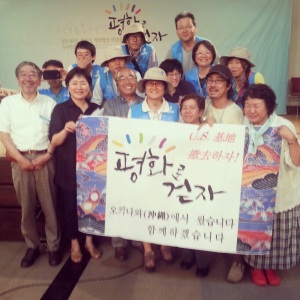
Activists from Osaka pose in solidarity with members of the International Peace March group
Gregory Elich, author and anti-war activist from the United States; Lei Xiong, Professor at Tsinghua University, Peking University, and Renmin University of China (People’s University of China); Ryoichi Hattori, Member of Japan’s House of Representatives (Social Democratic Party); Gyungsoon Park, South Korean author and Vice-president of the Progressive Policy Research Institute; and Ik-pyo Hong, Member of the Republic of Korea’s National Assembly (Democratic Unified Party). Speakers analyzed the inter-relatedness of the countries in Northeast Asia and argued that a precondition for peace on the Korean Peninsula included improved relations between China, Japan and Korea and a nuclear free East Asia. For instance, Mr. Hattori spoke of the importance of a denuclearized Japan, stating that after World War 2, Japan reformed its constitution to give up wars and nuclear weapons forever. The Korean War, however, provided a reason for Japan to re-militarize and to be used as an anti-communist outpost for the US. Currently, the Abe government is seeking to repeal the anti-war and anti-nuclear weapons reforms and further re-militarize the country. He stated that no country can justify peace by militarism and that no peace can be achieved by the production of war machines, such as nuclear weapons. The re-nuclearization and re-militarization of Japan would thus be an obstacle to peace for the region. Speakers also investigated whether peace is possible without reunification, what the obstacles to this process include and how to best overcome them. Several speakers mentioned the value of creating a safe space for a grassroots path to peace pioneered by civic and citizens groups and the importance of protecting individual ideas from repression under the banners of nationalism and state.
The speakers of the second session, “Joint Action for Peace in Northeast Asia”, included Kenju Watanabe of Japan, President of the South Korea-Japan People’s Solidarity Network and permanent board member of the Japanese Committee for Asia-Africa People’s Solidarity; Tim Shorrock, an American author, journalist and member of the Working Group for Peace
and De-militarization in Asia-Pacific Region; Jejun Joo, Policy Chair of the Korea Alliance of Progressive Movements; and Byong-ryul Min, member of Unified Progressive Party’s supreme council and founding member of the Democratic Labor Party. This session addressed how concerted actions can promote peace in the region. For example, Tim Shorrock noted the large-scale ignorance of the United States public on the issue of peace and re-unification even among leading progressive groups. He urged those in attendance to help each other educate Americans about the truth of Korean history and current affairs as they relate to peace and reunification from a Korean perspective. He labeled this as a precondition for peace, stating that the fanaticism constructed by the American media toward North Korea prevents popular support for the country and, in the minds of Americans, legitimizes United States military presence in the South, further securing the US geopolitical agenda in the region. Increasing education would likely decrease the fanaticism directed towards the North among the American general public and would create international solidarity in Korea’s quest for peace and reunification. This session demonstrated that the task of establishing peace on the peninsula extends beyond the borders of Korea- it is an issue that affects the world over, especially one characterized by a globalized economy and increasing global relationships.
Peace in Korea and in Northeast Asia is a complicated issue involving many parties, many conditions and many potential obstacles. It may not be an issue quickly resolved, but it is encouraging and hopeful to know that so many people are aligned in its recognition and are so tirelessly working for its realization. Conferences such as these are necessary steps in initiating and engaging in constructive dialogue targeted towards constructive goals. These dialogues, actions and initiatives help to build solidarity in the cause and are integral to peace and reunification in Korea.
2013 Gangjeong Grand March for Life and Peace
For more information on how to participate physically in the march, to offer one’s talents/work, to volunteer, or to offer a message of solidarity, please click here.
Photo Essay- 4 Days with the International Peace March from Jeju to Jiri Mountain
By Dae Han Song
The International Peace March started July 3rd at Gangjeong Village and continues until July 27th – the 60 year anniversary of the Armistice Agreement – when rallies will be held in front of the US Embassy and military bases in Seoul calling for a peace treaty to finally conclude the Korean War. Along the way, marchers will visit sites of the Korean War and ongoing struggles to reflect upon the connections between war, military spending, and division to militarization, social welfare, and political repression.
Day 1
The cultural night before the start of the International Peace March. Melodies of struggle floated upon warm tropical breezes. (To watch and listen to the performances, click here)
The first day of marching starts at Gangjeong Village, currently a site of struggle against construction of a naval base. (Visit the Save Jeju Now site for more information). Villagers and peace activists in South Korea and around the world oppose the naval base construction not only due to the destruction of villager’s livelihoods and the environment, but also due to its potential use as the site of a missile defense system. Located approximately 300 miles from Shanghai, this future naval base would likely house a US missile defense system to neutralize China’s missile capabilities. Above, the President of the Task Force Against Construction of the Jeju Naval Base updated us on the struggle. Due to the various fines levied against the protesters by the government, villagers are considering selling their community building to pay for outstanding fines.
With construction taking place behind us across a body of water, a member of the Unified Progressive Party relates the current status of the naval base construction. As the budget balloons past the projected cost, only 30 percent of the naval base has been completed because typhoons continue to delay and destroy construction.
“Peace is the Way”
Protesters have created sites of occupation and art all across the construction site calling for peace
and a halt to the naval base.
After occupations and direct resistance, the construction company Samsung erected barriers all along the site. The press conference launching the march took place at the construction site entrance.
The mayor of Gangjeong Village calls for peace at the press conference, saying, “The struggle in Gangjeong is directly connected to the struggle for a peace treaty.” The marcher’s vest reads, “Walking Towards Peace: An International Peace March to end the 60-year armistice agreement and establish a peace treaty.”
Marching while some chat and others upload photos and updates on social networking sites.
A banner reads “Oppose the Naval Base to the Death”
A moment of silence and reflection in honor of those killed during the April 3rd Jeju Uprising. Protests had erupted in Jeju against the separate 1948 elections in North and South Korea. Subsequent police repression and torture, along with the deployment of the right-wing Northwest Youth Corps, later sparked a guerrilla uprising. The police and military suppressed the guerrillas in 1949, in the process killing 25,000 to 30,000 islanders (1 in every 5 islanders) and destroying 230 villages (more than half). While such momentous events are recorded in official history, they are mostly absent from the general public’s consciousness. Moments such as these are reminders of the tragedies and horrors of war and testimonies for the need for peace.
The Korea Committee for the Preparation of State Construction was an organic body established for creation of an independent state immediately following the end of Japanese occupation. However, these autonomous state-construction efforts were shunned by the US, whose separate state-formation process revolved around Syngman Rhee and former Japanese collaborators. The orange areas on the map indicate cities and villages governed by people’s committees.
The grave sites of those killed in the April 3rd Uprisings.
One of the delegation – a netizen who traversed South Korea multiple times – brings along Che’s spirit.
Day 3
A cancelled rally offers the opportunity to practice our movement song and dance.
Marching in Changwon City.
Changwon City emerged and developed out of the surrounding industrial complexes and contains
a strong working class character.
Making new friends along the way
Members of local branches of Korea Woman Solidarity pump their fists while chanting for a peace treaty.
Day 4
Two surviving family members of guerrilla fighters pay their respects.
The letters above the altar read, “Prayer Ceremony for Peace.”
The ceremony was held at the base of Jiri Mountain to honor the guerrillas who fought against Japanese colonialism, and the Synghman Rhee government thereafter.
Family members of the deceased, peace marchers, and participants hold up a cloth path as a shaman
sends off the spirits of those killed in the Jiri mountains.
A Korean masked dancer plays a villager snatched from an idyllic existence and thrown into war.
The guerrilla stronghold of Jiri Mountain looms behind the ceremony site.
Nourishing our bodies with vitamin C tablets to stay healthy.
Clearly still healthy and full of energy, but still only the 4th day out of 21.
The grave site of the victims of the Sancheong-Hamyang Massacre in 1951. Seven hundred and five innocent villagers were killed as part of the army’s 11th division, 9th regiment, 3rd battalion’s efforts to liquidate communist guerrillas
on Jiri Mountain.
The author participated in the 21 day march for 4 days and 3 nights.
The Past, Present and Future of Korean Democracy: Stories from Busan’s Kim In-Gi
By Taryn Assaf
It began with a mouthwatering, fragrant dinner of dubu-kimchi, Korea’s stir-fried kimchi and tofu dish, and hae-mul pajeon, seafood and green onion pancake, at a restaurant called Min Ga (Commoner’s House), located in Busan’s PNU neighborhood (which, by the way, is dedicated to serving all natural, organic food grown locally in Korea and supports Korean farmers). Sitting on the floor of a humble dining room at the far end of a long wooden table, I faced a wall lined with massive ceramic pots made for fermenting kimchi; to my right, a busy little woman raced away in the kitchen, magically serving up dishes for another full dining room separated by the wall to my back. After licking our plates clean, the owner, Kim In-Gi, replaced our empty dishes with hwang-cha (Korean yellow tea) as he sat down to begin what would become a heartening conversation with an unforgettable man.
His story flowed with inexplicable ease, touring the chronology of his life experiences that led him into an intimate and influential position within the Busan chapter of the massive student led democracy movement of June 1987, which ended with the resignation of military dictator Chun Doo-Hwan and Korea’s first direct democratic elections. Philosophy, enlightenment, kidnappings, beatings, book burnings, controversy, corruption- he is no stranger to it all. And so his story reminds us of the incredible influence of people- their ideas, resilience and action- in creating a more equal and just society, but also how people’s ideas continue to stifle democracy in favor of the interests of the powerful elite classes. Fitting, then, that he ended the conversation with questions and concerns about the present and future of democracy in this country- how is democracy defined in Korea? Who decides what democracy looks like? Has democracy been achieved, or has it yet to be fully realized? This is the history of Korean democracy seen through the eyes of one man – one man’s role in the history of a nation.
Early Life and Experiences
Growing up extremely poor, Kim was never destined for a university education. His parents hardly made enough money to put food on the table, making the prospect of university for their children far beyond reach. He always had a zeal for study, however, and in his high school days would spend hours alone reading the philosophies of Plato and Aristotle. Becoming acquainted with various philosophical ideologies became a hobby. He soon extended his readings to the Eastern philosophies of Confucianism, Taoism and Buddhism, each influencing his understanding of the world and the people in it. When he finished high school, he had no chance of entering university because of his family situation, and so, determined to continue studying, enrolled in the air force academy, which was the best place for him to do so. Despite being able to continue studying philosophy, the situation in the air force was not ideal, and so he left to enter the military and complete his compulsory duty. After serving 33 months, he was more determined than ever to enter university. But the situation had worsened at home; his mother was sick and his brother was in jail- he needed to work to support his family. He was frequently asked why he had “given up his greatness in the military”- at the time, the military was considered a prosperous and stable occupation regarded with much prestige under the Park Chun-Hee government. He labored for his family, but his love for education never diminished. During this time he had traveled throughout Korea, and although his own family had no money and hardly a grain to eat, he encountered people much more desperate but also much happier than he. He discovered the true value of work, and, with his mind stabilized, he decided that he couldn’t postpone studying any longer.
University and the Fall of a Regime
When Kim began university, Korea was under tight military control. The country was experiencing somewhat of a political transformation; starting with the Seoul Spring (October 1979 to May 1980), rallies for democratization quickly spread throughout the country, calling for constitutional revisions that would lead to fair elections and would reflect the people’s political aspirations. These protests were harshly suppressed, revealing the aggressive and anti-democratic nature of the military, led by General Chun Doo-Hwan. By December 1979, Chun had overtaken the government in a military coup, and in the following year had crushed the demonstrations in Seoul, was responsible for the brutal attack that killed hundreds of civilians in the Gwangju uprising and had thrown the country into a state of martial law. This control extended into every realm of society, including the university. Under Chun’s regime, students and professors were constantly monitored by the military. What began as an attempt to block students and academia from exposing the truth about the regime’s role in the massacre in Gwangju (which they had elaborately covered up) eventually turned into a full scale ban of “radical” ideological books- Marxism, Leninism and countless other political and social philosophies- under the banner of “national security”. This action was legitimized by the National Security Law, which was enacted in 1948 in response to threats from North Korea, but was being used to justify repression of ideological materials and quell free speech under the guise of security. The Chun government constantly used the threat of North Korea to justify the repressive measures they placed on society.
“Government watchdogs always lived in hagwons (private schools) and universities. They monitored students constantly. Students lived in a constant state of fear, they always had the fear of kidnap or torture; living without fear was impossible. No one carried banned books. If they were caught, they were put in jail or tortured,” remarked Kim. On one occasion, Kim had been found with a book by Hegel in his possession; as punishment, he was taken to a remote location and beaten nearly to death. The 1980s were thus a very tumultuous time for university students. Students were gaining a new recognition of Korean society. Higher education revealed the paradoxes and gaps in the “anti-communist” ideologies they received from public education. They became frustrated with this realization and responded with anger and aggressiveness. “I never blamed anyone for their aggressiveness,” he said, “they were reacting in the right way.”
Students shifted their anger into action and began organizing. They organized into various groups with multiple associations and ideologies. Kim was not a part of any one group. He followed his own thoughts and ideas and through reading he developed his own way of analyzing social issues. In fact, for a year and a half he postponed his formal studies and spent 8 hours a day reading; by the end, he had read between 400 and 500 books, ending in a symbolic book burning ceremony, “I had finally realized what studying was for, and so, I ceremoniously burned the books in the establishment of my own worldview,” he said. Because of this, he was able to relate to many different student groups with different views for the movement. He was able to set himself apart and see the movement through different eyes. In this way, he drew a lot of attention to himself from the student public and became very popular; as a student of philosophy he was a great orator and regularly delivered speeches to instigate students into the movement for democracy. “I was not an essential figure in the movement,” he said, “but I was in a unique position where I could understand all facets of the protest from an objective viewpoint; because of this, I was also criticized, but as a philosophy student, I could not believe in one ideology without being critical of it.”
Tensions rose as the student movement progressed throughout the country. Students became increasingly frustrated by increasing controls that choked freedom at universities and restricted many other democratic freedoms throughout society. Kim kept up his role as an orator, and he continued encouraging people to come out and participate- in Busan, at its peak, the number of student protestors alone reached more than 20,000. After much organizing, the movement eventually moved from the campus to the streets, and, confronted by the aggressive military and riot police, became more militant in its methods. Students were beaten, almost to death, some mysteriously disappeared, hundreds were arrested and thousands more were confronted with tear gas and use of excessive force in their detainment. They never gave into the violence, however, and threw stones or whatever they could to fight back. “The general public became inspired by the student movement,” said Kim, and as the movement began embracing both political and social issues, students joined forces with citizens’ protests throughout the city. Movement leaders forged alliances with other sectors of society and broadened the scope of their struggle to include labor and workers struggles. Students and citizens worked together, and similar alliances could be found in every major city across the country, including Seoul, Daegu, Daejeon and Cheongju. With continuing mergers of civic and student groups, the movement focused its goals on democracy, calling for constitutional revision, anti-American independence, workers liberation and an end to the military dictatorship. The government continued its mass arrests, insisting that the movement demands were too similar to North Korean propaganda. They focused their arrests on student leaders, since they were able to bring out the most supporters. Slowly, reports of beatings and of torturing detainees spread throughout the movement, including the torture death of Park Jeong-Cheol in January, 1987. Paired with Chun’s announcement in April that he would suspend all discussion of constitutional amendments, people became angered and the movement gained new confidence in their mission to bring down the regime.
As mass protests continued throughout the country, in Busan, some 300,000 people took to the streets, unable to be controlled by police. “Citizens and students worked together in asking for Chun’s resignation,” said Kim. Chun realized his options were limited- either give in to the people’s demands or launch a military operation. However, the United States highly discouraged armed intervention, and with the Olympic games scheduled for Seoul the following year, a military operation was out of the question. Finally, on June 29th, 1987, the people “brought Chun to his knees,” as Kim put it. The June 29 Declaration, delivered by Chun’s successor, Roh Tae-Woo, promised popular presidential elections and the release of political prisoners. The movement had its victory and had brought many people hope, but for Kim and many others, it also brought despair.
Re-unification and the Question of Democracy
“People stopped asking for fundamental changes that come with democratization and were more content with the small achievement of winning the chance for a popular election,” noted Kim. “The common people did not aspire to a revolution any longer.” Divisions within the opposition party put a severe rift in the democratization movement, overshadowing the “small victory” of a popular election. The democratic left was divided into two parties, one led by Kim Dae-Jung and the other by Kim Yong-Sam, while the conservative candidacy belonged to Roh Tae-Woo. Efforts by the movement to unite the two Kims had failed, and in Korea’s first popular election, Roh Tae-Woo came out victorious, putting a dagger into the heart of the democracy movement. “After that, life didn’t change very much. Korea still holds the constitution from that time, and the meaning of democracy is still divided,” remarked Kim.
How is democracy divided in Korea? According to Kim, the largest obstacle to true democracy is the division of Korea itself. But the issue doesn’t start there. To evaluate democracy on the peninsula, “one must consider his view of history and how his life is involved with that history,” says Kim. For him, the issue starts from the era of Japanese colonialism. During this time, Korean elites actively supported the Japanese. They were primarily concerned with their self-interests, and as a result, were some of the few Koreans who benefitted from this arrangement. “For over 100 years, people were fooled by the privileged into believing that a democratic society can be achieved by following the rules of the elites.” No one dared themselves to achieve democracy (or liberation) because they were “brainwashed” for over a century to believe that democracy could be achieved through blind consent.
Kim believes that this still influences the public mindset when it comes to democratization. “The biggest problem facing Korea is reunification,” he says, “but no one is aware of the seriousness of the problem because reunification is not in the self-interest of the elite or the conservative government; those in power are not concerned with this issue,” and so this opinion trickles down to the rest of the population. “The current division of Korea is like the human body stifled by a tight belt. The blood circulation is terrible; we need to take off the belt and let the blood flow,” as he put it. To determine who is truly concerned about bettering Korea, we must recognize who is most concerned with reunification- the issue is about Korea’s and Korean’s future. One way to sustain peace on the peninsula and work toward reunification, in Kim’s opinion, would be to build more industrial complexes, such as the one at Kaeseong. By sending more South Koreans to work in these complexes, there would naturally be more exchanges between workers. In the face of tension between the two governments, workers from both sides would agree that they would sustain damage from the conflict, and so the potential to block it would be greater. Kim believes that this will naturally lead to better cooperation between the North and South, and the possibility of war will decrease. The threat of war will not decrease on the watch of the current government, who, just like the government before it, puts the Korean people under the threat of war by poorly managing efforts for peace. Peace is in the hands of the Korean people, and must be delivered by them and them alone. With July 2013 marking the 60th anniversary of the armistice agreement between the North and South, now is as good a time as any to reflect on the meaning of democracy in the context of peace and reunification.
Obstacles will always present themselves in the struggle for democracy, but “we should step over those obstacles and proceed, no matter how long it takes us; we should dare ourselves to achieve democracy, peace, and reunification. We need to determine what it means to be a democratic society- we can not wait. In order to realize that goal, we must always be aware of everything around us, and in time, history will bring a right and just society.” Kim’s story indicates how ordinary people are implicated in history- how their pasts influence the present and their future can be determined by the culmination of these experiences.
Please pay Mr. Kim and his wife a visit if you are in Busan and love healthy Korean food.
*An immense thank you to Eunkyung (Chris) Kim and Hyunsook (Geoffry) Kim for translation.
*If you would like to read more on the history of the democratization movement, please visit our resources page.
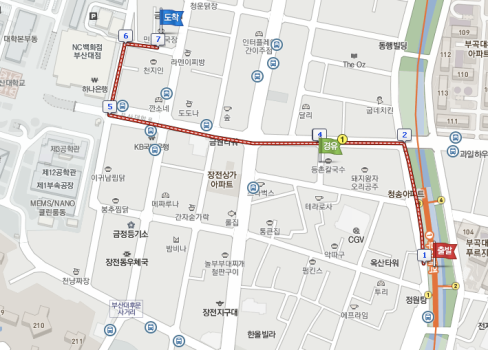
From exit 3 at Busandae subway stop, take a right. Turn left at the first busy street and walk to the first large intersection. Walk up toward the University’s main gate, but turn right at the NC Department store. Keeping to the right side of the road, turn right down the 2nd street and Min-Ga will be on your left down the 2nd tiny side street.
